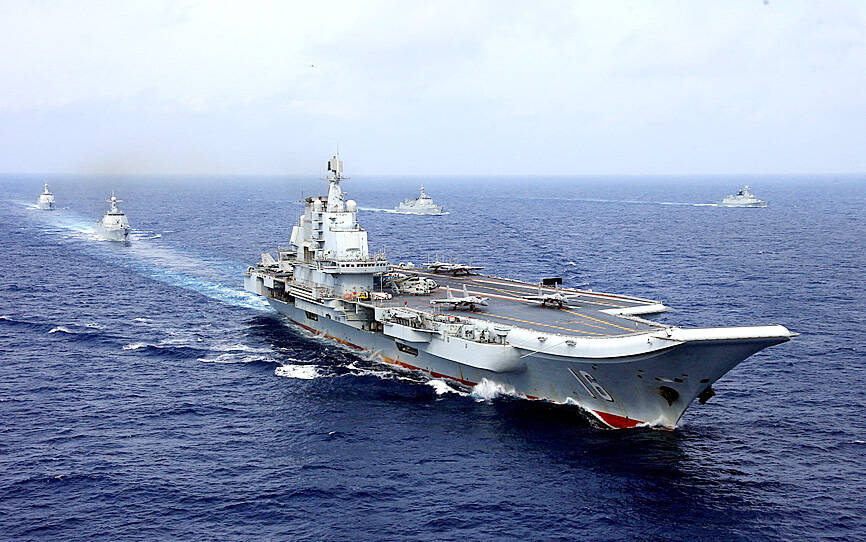China spent about US$15 billion, or 7 percent of its defense budget, on exercises in the western Pacific last year, according to a previously unpublished Taiwanese estimate, showing Beijing’s investment in military activity around Taiwan and its neighbors.
The internal research by the military, reviewed by Reuters, offers a rare look into a slice of China’s defense spending as Beijing has ramped up its military presence amid rising tensions in the region.
China claims Taiwan as its own and is also locked in disputes with several nations over sovereignty of large parts of the South China Sea and the East China Sea.

Photo: Reuters
“This reveals the logic of allocation of their resources,” a senior official briefed on the research said. “They are spending a huge amount of resources trying to gain control of the west of the first island chain.”
The official, and two other people briefed on the research, declined to be identified for this story because of the sensitivity of the matter.
The first island chain is a collection of archipelagos running roughly from Indonesia in an arc to northeast to Japan, encompassing the South China Sea and East China Sea.
In a statement to Reuters, the Ministry of National Defense declined to comment on the figures.
“But the Chinese Communist Party’s enormous military investment in recent years indeed has a negative impact to the peace and stability in the region, which is not conducive to global prosperity and development,” the ministry said.
The Chinese Ministry of National Defense did not respond to a request for comment.
Zhang Youxia (張又俠), vice chairman of the Central Military Commission and China’s second-highest-ranking military official, in April said that the sea should not be an arena where nations can flex their “gunboat muscles.”
Carrying out “maritime containment, encirclement and island blockades will only plunge the world into a vortex of division and turbulence,” he said, in an apparent reference to the US and its allies.
The Ministry of National Defense compiled the reports in May based on surveillance and intelligence on Chinese military activity in the Bohai Sea off northeast China, the East China Sea, the Taiwan Strait, the South China Sea and the western Pacific.
The reports tallied China’s naval and air missions there last year, then estimated how much fuel and other consumables would cost for each hour of activity. The total was 110 billion yuan (US$15.4 billion), including maintenance, repairs and salaries, the reports and the officials briefed on the research said.
The research was designed to help Taiwanese decisionmakers understand how China allocates military resources across regions, as well as to gauge what Taipei perceives as a “gap” between Beijing’s intentions and its capabilities, three officials briefed on the reports said.
Comparing the cost of the exercises with the state of China’s economy, they said, helps Taipei assess the risks for both Taiwan and China.
The 110 billion yuan figure amounts to about 85 percent of Taiwan’s defence budget last year, Reuters calculations showed.
It is about 7 percent of China’s reported military spending of 1.55 trillion yuan last year, although diplomats and experts say that number is often opaque or not fully inclusive. China in March announced a 7.2 percent rise in defense spending for this year to 1.67 trillion yuan.
“It’s like a black hole,” retired navy Lieutenant Commander Lu Li-shih (呂禮詩) said, adding that individual spending programs were not broken out in China’s defense budget.
“You can gauge the trend, but you can’t tell what the detailed items are,” Lu said.
Both Washington and Beijing have significantly increased the volume of military exercises across Asia amid roiling tensions, though China’s drills still lag in scale and complexity, a study has found.
China’s Global Times newspaper last year said that sending carrier groups into the waters of the western Pacific was not only about flexing muscles around Taiwan, and that China’s navy needed to get used to operating far out at sea.
Four experts said the reports’ methodology was feasible and could provide valuable information, although they cautioned that it necessarily included some guesswork.
They also said direct comparisons on military exercise spending were difficult; no data was available, for instance, on how much the US spent on such activities last year, but the US Department of Defense has proposed spending US$9.9 billion next year on the Pacific Deterrence Initiative, created to counter China’s military buildup.
China has stepped up military incursions and war games near Taiwan.
Chinese aircraft, including J-10 fighter jets, H-6 bombers and drones, last year made more than 9,200 flights in the region, amounting to about 29,000 hours in the air, the report showed.
The Chinese navy made more than 70,000 sailings, including aircraft carriers and destroyers, amounting to a total time at sea of more than 1.7 million hours.
About 40 percent of the Chinese naval journeys were made in the highly contested South China Sea, about 20 percent were in the East China Sea bordering Japan and South Korea, and nearly 15 percent were in the Taiwan Strait, the report showed.
China also launched “punishment” drills around Taiwan in May, sending heavily armed warplanes and staging mock attacks shortly after President William Lai (賴清德), who Beijing considers a separatist, took office.
During the two-day “Joint Sword 2024A” war games that month, Chinese air and naval forces were estimated to have spent about US$13.17 million on fuel and consumables, according to another Taiwanese defense report reviewed by Reuters.
The estimated spending for that exercise did not include personnel and maintenance, which are usually about three times the cost of fuel and consumables, the three officials briefed on the research said.

The US government has signed defense cooperation agreements with Japan and the Philippines to boost the deterrence capabilities of countries in the first island chain, a report by the National Security Bureau (NSB) showed. The main countries on the first island chain include the two nations and Taiwan. The bureau is to present the report at a meeting of the legislature’s Foreign Affairs and National Defense Committee tomorrow. The US military has deployed Typhon missile systems to Japan’s Yamaguchi Prefecture and Zambales province in the Philippines during their joint military exercises. It has also installed NMESIS anti-ship systems in Japan’s Okinawa

‘WIN-WIN’: The Philippines, and central and eastern European countries are important potential drone cooperation partners, Minister of Foreign Affairs Lin Chia-lung said Minister of Foreign Affairs Lin Chia-lung (林佳龍) in an interview published yesterday confirmed that there are joint ventures between Taiwan and Poland in the drone industry. Lin made the remark in an exclusive interview with the Chinese-language Liberty Times (the Taipei Times’ sister paper). The government-backed Taiwan Excellence Drone International Business Opportunities Alliance and the Polish Chamber of Unmanned Systems on Wednesday last week signed a memorandum of understanding in Poland to develop a “non-China” supply chain for drones and work together on key technologies. Asked if Taiwan prioritized Poland among central and eastern European countries in drone collaboration, Lin

BACK TO WORK? Prosecutors said they are considering filing an appeal, while the Hsinchu City Government said it has applied for Ann Kao’s reinstatement as mayor The High Court yesterday found suspended Hsinchu mayor Ann Kao (高虹安) not guilty of embezzling assistant fees, reducing her sentence to six months in prison commutable to a fine from seven years and four months. The verdict acquitted Kao of the corruption charge, but found her guilty of causing a public official to commit document forgery. The High Prosecutors’ Office said it is reviewing the ruling and considering whether to file an appeal. The Taipei District Court in July last year sentenced Kao to seven years and four months in prison, along with a four-year deprivation of civil rights, for contravening the Anti-Corruption

NO CONFIDENCE MOTION? The premier said that being toppled by the legislature for defending the Constitution would be a democratic badge of honor for him Premier Cho Jung-tai (卓榮泰) yesterday announced that the Cabinet would not countersign the amendments to the local revenue-sharing law passed by the Legislative Yuan last month. Cho said the decision not to countersign the amendments to the Act Governing the Allocation of Government Revenues and Expenditures (財政收支劃分法) was made in accordance with the Constitution. “The decision aims to safeguard our Constitution,” he said. The Constitution stipulates the president shall, in accordance with law, promulgate laws and issue mandates with the countersignature of the head of the Executive Yuan, or with the countersignatures of both the head of the Executive Yuan and ministers or